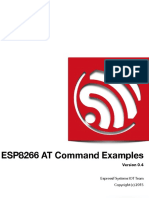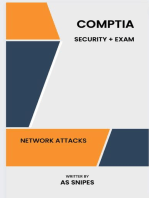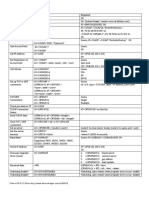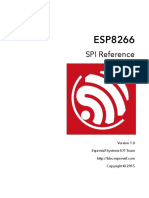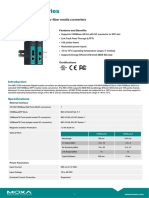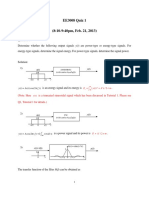4B-ESP8266 at Command Examples en v1.3
Uploaded by
zaleks4B-ESP8266 at Command Examples en v1.3
Uploaded by
zaleksESP8266 AT Command Examples
Version 1.3
Espressif Systems IOT Team
Copyright 2015
Espressif Systems
ESP8266 AT Command Examples
!
Disclaimer and Copyright Notice
Information in this document, including URL references, is subject to change without notice.
THIS DOCUMENT IS PROVIDED AS IS WITH NO WARRANTIES WHATSOEVER, INCLUDING ANY
WARRANTY OF MERCHANTABILITY, NON-INFRINGEMENT, FITNESS FOR ANY PARTICULAR
PURPOSE, OR ANY WARRANTY OTHERWISE ARISING OUT OF ANY PROPOSAL, SPECIFICATION
OR SAMPLE. All liability, including liability for infringement of any proprietary rights, relating to use
of information in this document is disclaimed. No licenses express or implied, by estoppel or
otherwise, to any intellectual property rights are granted herein.
The WiFi Alliance Member Logo is a trademark of the WiFi Alliance.
All trade names, trademarks and registered trademarks mentioned in this document are property of
their respective owners, and are hereby acknowledged.
Copyright 2015 Espressif Systems Inc. All rights reserved.
Espressif Systems Confidential
2 /16
Friday, Oct 23, 2015
Espressif Systems
ESP8266 AT Command Examples
!
Table of Contents
1.
Preambles .................................................................................................. 4
2.
Single Connection as TCP Client .............................................................. 5
3.
UDP Transmission ...................................................................................... 7
4.
3.1.
UDP (remote IP and port are fixed) .........................................................8
3.2.
UDP (remote IP, port can be changed) ...................................................9
Transparent Transmission........................................................................ 10
4.1.
TCP client single connection UART - WiFi passthrough .......................10
4.2.
UDP transmission UART - WiFi passthrough ........................................12
5.
Multiple Connection as TCP Server .......................................................14
6.
Questions & Answers ...............................................................................16
Espressif Systems Confidential
3 /16
Friday, Oct 23, 2015
Espressif Systems
ESP8266 AT Command Examples
!
1.
Preambles
Herein we introduces some specific examples on the usage of Espressif AT Commands. For more
information about the complete instruction set, please refer to documentation 4A-ESP8266__AT
Instruction Set .
(1)
Flash in AT bin files which supports AT commands (/esp_iot_sdk/bin/at) into the ESP8266
device, according to readme.txt there.
(2)
Power on device and set serial baud rate to 115200. Enter AT commands.
Note: Please pay attention to the new line mode, AT command need /r/n to be the end.
Espressif Systems Confidential
4 /16
Friday, Oct 23, 2015
Espressif Systems
2.
Single Connection as TCP Client
Set WiFi mode:
AT+CWMODE=3
Response :OK
// softAP+station mode
Connect to router:
AT+CWJAP="SSID", "password"
Response :OK
// SSID and password of router
Query devices IP:
AT+CIFSR
Response :192.168.3.106
ESP8266 AT Command Examples
!
// Device got an IP from router.
Connect PC to the same router that ESP8266 is connected to.
Using a network tool on the computer to create a server.
ESP8266 connect to server as a client:
AT+CIPSTART="TCP", "192.168.3.116", 8080
Response :OK
//protocolserver IP & port
Send data:
AT+CIPSEND=4
// set date length which will be sent,
>DGFY
// enter the data,
Response :SEND OK
such as 4 bytes
no CR
Note: If the number of bytes sent is bigger than the size defined (n), will reply busy, and after
sending n number of bytes, reply SEND OK.
Espressif Systems Confidential
5 /16
Friday, Oct 23, 2015
Espressif Systems
ESP8266 AT Command Examples
!
Receive data:
+IPD, n: xxxxxxxxxx
Espressif Systems Confidential
// received n bytes,
6 /16
data=xxxxxxxxxxx
Friday, Oct 23, 2015
Espressif Systems
ESP8266 AT Command Examples
!
3.
UDP Transmission
UDP transmission is established via AT+CIPSTART. There is no such definition as UDP server or UDP
client. For more information about AT commands, please refer to documentation 4A-ESP8266__AT
Instruction Set .
Set WiFi mode :
AT+CWMODE=3
Response :OK
// softAP+station mode
Connect to router:
AT+CWJAP="SSID", "password"
Response :OK
// SSID and password of router
Query devices IP:
AT+CIFSR
Response :+CIFSR: STAIP, "192.168.101.104" // IP address of ESP8266 station
Connect PC to the same router as ESP8266 is connected to.
Using a network tool on the computer to create a UDP .
Below is two examples on UDP transmission.
Espressif Systems Confidential
7 /16
Friday, Oct 23, 2015
3.1.
Espressif Systems
ESP8266 AT Command Examples
!
UDP (remote IP and port are fixed)
In UDP transmission, whether remote IP and port is fixed or not is decided by the last parameter of
AT+CIPSTART. 0 means that the remote IP and port is fixed and cannot be changed. A specific ID
is given to such connection, making sure that the data sender and receiver will not be replaced by
other devices.
Enable multiple connection:
AT+CIPMUX=1
Response :OK
Create a UDP transmission, for example, ID is 4.
AT+CIPSTART=4, "UDP", "192.168.101.110", 8080, 1112, 0
Response :4, CONNECT
OK
Note :
"192.168.101.110", 8080 here is the remote IP and port of UDP transmission of the opposite side,
i.e., the configuration set by PC.
1112 is the local port of ESP8266. User can self-define this port. The value of this port will be random
if its not defined beforehand.
0 means that remote IP and port is fixed and cannot be changed. For example, if another PC also
creates a UDP entity and sends data to ESP8266 port 1112. ESP8266 can receive data sent from
UDP port 1112, but when data is sent using AT command AT+CIPSEND=4, X, it will still be sent to
the first PC end. If this parameter is not 0, it will send to a new PC.
Send data:
AT+CIPSEND=4, 5
// Send 5 bytes to transmission NO.4
>DGFYQ
// enter the data, no CR
Response :SEND OK
Note:
If the number of bytes sent is bigger than the size defined (n), will reply busy, and after sending n
number of bytes, reply SEND OK.
Receive data:
+IPD, 4, n: xxxxxxxxxx
// received n bytes,
data=xxxxxxxxxxx
Delete UDP transmission NO.4:
AT+CIPCLOSE=4
Response :4, CLOSED
OK
Espressif Systems Confidential
8 /16
Friday, Oct 23, 2015
3.2.
Espressif Systems
ESP8266 AT Command Examples
!
UDP (remote IP, port can be changed)
Create a UDP transmission, last parameter is 2.
AT+CIPSTART="UDP", "192.168.101.110", 8080, 1112, 2
Response :CONNECT
OK
Note :
"192.168.101.110", 8080 here refer to the remote IP and port of UDP transmission terminal which
is created on PC in step 4;
1112 is the local port of ESP8266. User can self-define this port. The value of this port will be random
if its not defined beforehand.
2 means the opposite terminal of UDP transmission side will change to be the latest one that has
been communicating with ESP8266.
Send data:
AT+CIPSEND=5
// Send 5 bytes
>DGFYQ
// enter the data,
Response :SEND OK
no CR
Note:
If the number of bytes sent is bigger than the size defined (n), will reply busy, and after sending n
number of bytes, reply SEND OK.
If you want to send data to any other UDP terminals, please set the IP and port of this terminal.
AT+CIPSEND=6, 192.168.101.111, 1000
>abcdef
// enter the data,
Response :SEND OK
no CR
Receive data:
+IPD, n: xxxxxxxxxx
// Send 6 bytes
// received n bytes,
data=xxxxxxxxxxx
Delete UDP transmission:
AT+CIPCLOSE
Response :CLOSED
OK
Espressif Systems Confidential
9 /16
Friday, Oct 23, 2015
Espressif Systems
4.
ESP8266 AT Command Examples
!
Transparent Transmission
Transparent transmission is enabled only when ESP8266 is working as TCP client creating a single
connection, or in UDP transmission.
4.1.
TCP client single connection UART - WiFi passthrough
Here is an example that ESP8266 station as TCP client to create a single connection and execute
transparent transmission. For ESP8266 soft-AP, it can execute transparent transmission in the similar
way. For more information about AT commands, please refer to documentation 4A-ESP8266__AT
Instruction Set .
Set WiFi mode :
AT+CWMODE=3
Response :OK
// softAP+station mode
Connect to router:
AT+CWJAP="SSID", "password"
Response :OK
Query devices IP:
AT+CIFSR
Response :192.168.101.105
// SSID and password of router
// Devices IP that got from router.
Connect PC to the same router that ESP8266 is connected to.
Using a network tool on the computer to create a server.
Espressif Systems Confidential
10/16
Friday, Oct 23, 2015
Espressif Systems
ESP8266 AT Command Examples
!
Device connect to server:
AT+CIPSTART="TCP", "192.168.101.110", 8080
Response :OK
Linked
// protocolserver IP & port
Enable transparent transmission mode:
AT+CIPMODE=1
Response :OK
Start sending data:
AT+CIPSEND
Response: >
//From now on,
transparent transmitted to server.
data received from UART will be
The network tool on PC will receive the data.
Stop sending data:
If received a packet of data that contains only +++, then the transparent transmission process will
be stopped. Please wait at least 1 second before sending next AT command.
Please be noted that if you input +++ directly by typing, the +++, may not be recognised as three
consecutive + because of the Prolonged time when typing.
Note:
The aim of ending +++ is to exit transparent transmission and turn back to accept normal AT
command, while TCP still remains connected. However, we can also use command AT+CIPSEND to
turn back into transparent transmission.
Disable UART - WiFi passthrough mode (transparent transmission)
AT+CIPMODE=0
Response : OK
Delete TCP connection:
AT+CIPCLOSE
Response :CLOSED
OK
Espressif Systems Confidential
11/16
Friday, Oct 23, 2015
4.2.
Espressif Systems
ESP8266 AT Command Examples
!
UDP transmission UART - WiFi passthrough
Here is an example that ESP8266 soft-AP create a UDP transparent transmission. For ESP8266
station, it can execute UDP transparent transmission in the similar way. For more information about
AT commands, please refer to documentation 4A-ESP8266__AT Instruction Set .
Set WiFi mode :
AT+CWMODE=3
Response :OK
// softAP+station mode
Connect PC to ESP8266 soft-AP
Using a network tool on PC to create a UDP.
Device create a UDP transmission which remote IP and port are fixed.
AT+CIPSTART="UDP","192.168.4.2",1001,2233,0
Response :OK
Enable transparent transmission mode:
AT+CIPMODE=1
Response :OK
Start sending data:
AT+CIPSEND
Espressif Systems Confidential
12/16
Friday, Oct 23, 2015
Espressif Systems
ESP8266 AT Command Examples
!
Response: >
//From now on,
transparent transmitted to server.
data received from UART will be
Stop sending data:
If a packet of data that contains only +++, then the transparent transmission process will be
stopped. Please wait at least 1 second before sending next AT command.
Please be noted that if you input +++ directly by typing, the +++, may not be recognised as three
consecutive + because of the Prolonged time when typing.
Note:
The aim of ending +++ is to exit transparent transmission and turn back to accept normal AT
command, while UDP transmission still exists. However, we can also use command AT+CIPSEND to
turn back into transparent transmission.
Disable UART - WiFi passthrough mode (transparent transmission)
AT+CIPMODE=0
Response : OK
Delete UDP transmission:
AT+CIPCLOSE
Response :CLOSED
OK
Espressif Systems Confidential
13/16
Friday, Oct 23, 2015
5.
Espressif Systems
ESP8266 AT Command Examples
!
Multiple Connection as TCP Server
When ESP8266 is working as a TCP server, a multiple of connections shall be maintained. That is to
say, there should be more than one client connecting to ESP8266.
Here is an example showing how TCP server is realized when ESP8266 is working in softAP mode:
Set WiFi mode :
AT+CWMODE=3
Response :OK
// softAP+station mode
Enable multIPle connection:
AT+CIPMUX=1
Response :OK
Setup server:
AT+CIPSERVER=1
Response :OK
// default port = 333
Connect PC to ESP8266 soft-AP
Using a network tool on PC to create a TCP client and connect to ESP8266.
Espressif Systems Confidential
14/16
Friday, Oct 23, 2015
Espressif Systems
ESP8266 AT Command Examples
!
Note:
When ESP8266 is working as a TCP server, there exists a timeout mechanism. If the TCP client is
connected to the ESP8266 TCP server, whereas there is no data transmission for a period of time,
then the server will stop the connection with the client. To avoid such problems, please set up a data
transmission circulation every 5 seconds.
Send data:
// ID number of connection is defaulted to be 0.
AT+CIPSEND=0, 4
// send 4 bytes to connection NO.0
>iopd
// enter the data,
no CR
Response :SEND OK
Note:
If the number of bytes sent is bigger than the size defined (n), will reply busy, and after sending n
number of bytes, reply SEND OK.
Receive data:
+IPD, 0, n: xxxxxxxxxx
// received n bytes,
data = xxxxxxxxxx
Delete one TCP connection:
AT+CIPCLOSE=0
Response :0, CLOSED
// Delete NO.0 connection.
OK
Espressif Systems Confidential
15/16
Friday, Oct 23, 2015
Espressif Systems
ESP8266 AT Command Examples
!
6.
Questions & Answers
If you have any questions about the execution of AT instructions, please contact supportat@espressif.com. Please describe the issues that you encountered with information as follows:
Version info or AT Command: You can use command AT+GMR to acquire your current AT
command version info.
Hardware Module info :example AITHINK ESP-01
Screenshot of the test steps, for example:
If possible, please provide the printed log information, such as:
ets Jan
8 2013, rst cause: 1,
load 0x40100000,
len 26336,
boot mode: (3, 3)
room 16
tail 0
chksum 0xde
load 0x3ffe8000,
len 5672,
room 8
len 8348,
room 8
tail 0
chksum 0x69
load 0x3ffe9630,
tail 4
chksum 0xcb
csum 0xcb
SDK version: 0.9.1
addr not ack when tx write cmd
Espressif Systems Confidential
16/16
Friday, Oct 23, 2015
You might also like
- Tyler Wrightson - Wireless Network Security - A Beginner's Guide-McGraw-Hill Education (2012)No ratings yetTyler Wrightson - Wireless Network Security - A Beginner's Guide-McGraw-Hill Education (2012)369 pages
- IPv4 Subnetting for Beginners: Your Complete Guide to Master IP Subnetting in 4 Simple Steps: Computer Networking, #1From EverandIPv4 Subnetting for Beginners: Your Complete Guide to Master IP Subnetting in 4 Simple Steps: Computer Networking, #15/5 (3)
- ESP8266 AT Command Examples: Espressif Systems IOT TeamNo ratings yetESP8266 AT Command Examples: Espressif Systems IOT Team14 pages
- 4A-ESP8266 AT Instruction Set - v0.22 PDFNo ratings yet4A-ESP8266 AT Instruction Set - v0.22 PDF53 pages
- 4A-AT-ESP8266 AT Instruction Set - v0.23 PDFNo ratings yet4A-AT-ESP8266 AT Instruction Set - v0.23 PDF53 pages
- 4A-ESP8266 - AT Instruction Set - EN - v1.5No ratings yet4A-ESP8266 - AT Instruction Set - EN - v1.569 pages
- 4a-Esp8266 at Instruction Set en v1.5.4 0 ESP8266No ratings yet4a-Esp8266 at Instruction Set en v1.5.4 0 ESP826671 pages
- DevKitC - Getting - Started - Guide - EN ESP8266No ratings yetDevKitC - Getting - Started - Guide - EN ESP826611 pages
- CISCO PACKET TRACER LABS: Best practice of configuring or troubleshooting NetworkFrom EverandCISCO PACKET TRACER LABS: Best practice of configuring or troubleshooting NetworkNo ratings yet
- AT Command Examples of WT32-ETH01 Wired Module_v1.1No ratings yetAT Command Examples of WT32-ETH01 Wired Module_v1.126 pages
- ESP8266 WiFi Module Quick Start Guide V 1.0.4100% (1)ESP8266 WiFi Module Quick Start Guide V 1.0.415 pages
- Computer Networking: An introductory guide for complete beginners: Computer Networking, #1From EverandComputer Networking: An introductory guide for complete beginners: Computer Networking, #14.5/5 (2)
- We Need Arduino and Wifi Module: When You Receive The Module, You Need To Update The Firmware in The ModuleNo ratings yetWe Need Arduino and Wifi Module: When You Receive The Module, You Need To Update The Firmware in The Module4 pages
- Esp32 at Instruction Set and Examples enNo ratings yetEsp32 at Instruction Set and Examples en58 pages
- Esp8266 Based Serial Wifi Shield For Arduino UserNo ratings yetEsp8266 Based Serial Wifi Shield For Arduino User18 pages
- Esp at en v2.3.0.0 - Esp32c3 414 Gacc4d219 Esp32No ratings yetEsp at en v2.3.0.0 - Esp32c3 414 Gacc4d219 Esp32399 pages
- Hardware Design Guidelines: Espressif SystemsNo ratings yetHardware Design Guidelines: Espressif Systems36 pages
- Network with Practical Labs Configuration: Step by Step configuration of Router and Switch configurationFrom EverandNetwork with Practical Labs Configuration: Step by Step configuration of Router and Switch configurationNo ratings yet
- Esp8266 Wifi Module Quick Start Guide V 1.0.4No ratings yetEsp8266 Wifi Module Quick Start Guide V 1.0.415 pages
- Basic Networking with ESP8266 WIFI moduleNo ratings yetBasic Networking with ESP8266 WIFI module4 pages
- 20a-Esp8266 Rtos SDK Programming Guide en v1.4.0No ratings yet20a-Esp8266 Rtos SDK Programming Guide en v1.4.046 pages
- 8q Esp8266 Hspi Host Multi Device API en v1.0No ratings yet8q Esp8266 Hspi Host Multi Device API en v1.07 pages
- 20B-ESP8266 - RTOS - SDK - API Reference - v1.3.0No ratings yet20B-ESP8266 - RTOS - SDK - API Reference - v1.3.0176 pages
- 8h-Esp8266 Interface Sdio Spi Mode en v0.1-2No ratings yet8h-Esp8266 Interface Sdio Spi Mode en v0.1-214 pages
- 8q Esp8266 Hspi Host Multi Device API en v1.0No ratings yet8q Esp8266 Hspi Host Multi Device API en v1.07 pages
- 9B-ESP8266 Sleep Function Description en v1.0No ratings yet9B-ESP8266 Sleep Function Description en v1.09 pages
- 8P-ESP8266 I2S Module Description en v1.0No ratings yet8P-ESP8266 I2S Module Description en v1.012 pages
- 8J-ESP8266 SPI-WiFi Passthrough 2-Interrupt Mode en v1.0No ratings yet8J-ESP8266 SPI-WiFi Passthrough 2-Interrupt Mode en v1.011 pages
- Product Specification: Approval ElectricalNo ratings yetProduct Specification: Approval Electrical1 page
- IMC-21GA Series: Industrial Gigabit Ethernet-To-Fiber Media ConvertersNo ratings yetIMC-21GA Series: Industrial Gigabit Ethernet-To-Fiber Media Converters3 pages
- Q26C MLB Gen X 051-6496 Ra 820-1501 20030619No ratings yetQ26C MLB Gen X 051-6496 Ra 820-1501 2003061974 pages
- Xigmanas - Basic FTP Client ConfigurationNo ratings yetXigmanas - Basic FTP Client Configuration6 pages
- Savitribai Phule Pune University: Timetable For Fresh & Backlog Online Examination of October/November 2021No ratings yetSavitribai Phule Pune University: Timetable For Fresh & Backlog Online Examination of October/November 20219 pages
- MG - Networking - L4 - Apply Network FundamentalsNo ratings yetMG - Networking - L4 - Apply Network Fundamentals18 pages
- S (3) : S E T: College of Engineering & TechnologyNo ratings yetS (3) : S E T: College of Engineering & Technology3 pages
- LTE Product-SDR BBU&RRU Hardware: ZTE UniversityNo ratings yetLTE Product-SDR BBU&RRU Hardware: ZTE University22 pages
- Mpc1 Multi Purpose Can Controller - Reference Manual: Baldur Gíslason December 17, 2018No ratings yetMpc1 Multi Purpose Can Controller - Reference Manual: Baldur Gíslason December 17, 20186 pages
- Voxai Solutions Firewall Ruleset Review H1 Report v1.1 February 28 2023 CNo ratings yetVoxai Solutions Firewall Ruleset Review H1 Report v1.1 February 28 2023 C11 pages
- IPC HFW5842DK1 Z4 5G - Datasheet - 20220927No ratings yetIPC HFW5842DK1 Z4 5G - Datasheet - 202209274 pages
- Tyler Wrightson - Wireless Network Security - A Beginner's Guide-McGraw-Hill Education (2012)Tyler Wrightson - Wireless Network Security - A Beginner's Guide-McGraw-Hill Education (2012)
- IPv4 Subnetting for Beginners: Your Complete Guide to Master IP Subnetting in 4 Simple Steps: Computer Networking, #1From EverandIPv4 Subnetting for Beginners: Your Complete Guide to Master IP Subnetting in 4 Simple Steps: Computer Networking, #1
- ESP8266 AT Command Examples: Espressif Systems IOT TeamESP8266 AT Command Examples: Espressif Systems IOT Team
- CISCO PACKET TRACER LABS: Best practice of configuring or troubleshooting NetworkFrom EverandCISCO PACKET TRACER LABS: Best practice of configuring or troubleshooting Network
- Network with Practical: ALL PACKET TRACER LABSFrom EverandNetwork with Practical: ALL PACKET TRACER LABS
- AT Command Examples of WT32-ETH01 Wired Module_v1.1AT Command Examples of WT32-ETH01 Wired Module_v1.1
- Computer Networking: An introductory guide for complete beginners: Computer Networking, #1From EverandComputer Networking: An introductory guide for complete beginners: Computer Networking, #1
- We Need Arduino and Wifi Module: When You Receive The Module, You Need To Update The Firmware in The ModuleWe Need Arduino and Wifi Module: When You Receive The Module, You Need To Update The Firmware in The Module
- Network with Practical Labs Configuration: Step by Step configuration of Router and Switch configurationFrom EverandNetwork with Practical Labs Configuration: Step by Step configuration of Router and Switch configuration
- 8J-ESP8266 SPI-WiFi Passthrough 2-Interrupt Mode en v1.08J-ESP8266 SPI-WiFi Passthrough 2-Interrupt Mode en v1.0
- IMC-21GA Series: Industrial Gigabit Ethernet-To-Fiber Media ConvertersIMC-21GA Series: Industrial Gigabit Ethernet-To-Fiber Media Converters
- Savitribai Phule Pune University: Timetable For Fresh & Backlog Online Examination of October/November 2021Savitribai Phule Pune University: Timetable For Fresh & Backlog Online Examination of October/November 2021
- S (3) : S E T: College of Engineering & TechnologyS (3) : S E T: College of Engineering & Technology
- Mpc1 Multi Purpose Can Controller - Reference Manual: Baldur Gíslason December 17, 2018Mpc1 Multi Purpose Can Controller - Reference Manual: Baldur Gíslason December 17, 2018
- Voxai Solutions Firewall Ruleset Review H1 Report v1.1 February 28 2023 CVoxai Solutions Firewall Ruleset Review H1 Report v1.1 February 28 2023 C




